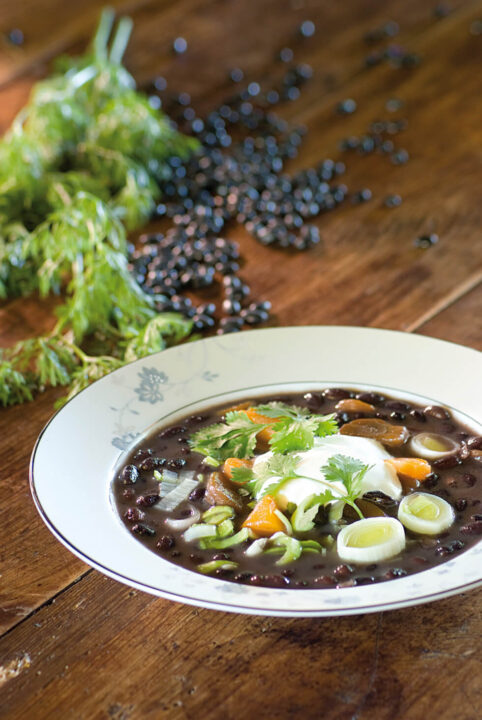Legumes – a group that includes beans, peas and lentils, as well as peanuts – are a wonderful and inexpensive source of high-quality nutrition and nourishment. They are packed with fiber, complex carbohydrates, B vitamins, calcium and iron. Legumes are the most complete source of plant-based protein, offering grounding and strengthening energies. The chemical genistein in beans helps to reduce the growth of tumors by preventing blood vessels from attaching to them.
Certain familiar legumes, including green beans, green peas and lima beans, can be harvested when they are immature. In this state, they are considered vegetables. Others, such as all other beans and peas as well as lentils, are picked as mature legumes and are generally dried. In many cultures around the world, legumes and grains are eaten together, and the combination provides the body with a complete set of essential amino acids. The pairing of rice with beans is a staple in South and Central America, and the grain-and-legume combination appears in Europe as well – as in pea soup, which is traditionally cooked with barley. Kama, an Estonian specialty, is a coarsely ground mixture of peas and grains, eaten with sour milk or yogurt as a light summer meal.
Beans are known to strengthen the kidneys and adrenal glands. Note their similarity in shape to the kidneys! Overtaxed adrenals and kidneys will lead to a decrease in vitality and sexual energy. Beans can help to restore both. After eating legumes, many people experience digestive difficulties such as gas and intestinal irritability. This is caused by certain complex carbohydrates that do not digest in the small intestines and are later broken down by bacteria in the large intestines, where they release gas. (Similar carbohydrates are found in members of the cabbage family.) If legumes are new to you, start with the smaller ones, such as lentils, mung beans or adzuki beans. Soak and cook your beans for a long enough time and add spices and herbs in the cooking process. Puréeing can also make legumes more easily digestible. Experiment with smaller amounts and gradually build up your tolerance by increasing the size of your portions. However you prepare them, chewing your beans well will facilitate digestion.
Basic Cooking Instructions
Most dried legumes need to be soaked for at least six hours – preferably overnight – to enhance digestibility and to neutralize antinutritional factors that can interfere with mineral absorption. Lentils, split peas and adzuki beans do not need to be soaked.
1 To soak, place rinsed legumes in a pot and add at least four times as much water as there are beans. Soak for at least six hours or overnight – soaking longer than overnight will not hurt legumes.
2 Prior to cooking, discard the soaking water and add fresh water. Bring the legumes to a boil and continue to boil over medium heat. Most legumes (except lentils and chickpeas) produce foam at the beginning of the cooking process. Skim off and discard the foam.
3 Add a piece of seaweed to enhance taste and speed up cooking time. Seaweed plays the same role as the traditional ham bone would: as calcium-rich foods, both help to tenderize legumes.
4 Check the legumes toward the end of the estimated cooking time. They are done when their centers are soft.
5 Wait until the beans are almost cooked before adding salt or soy sauce because salt slows down the cooking process.
Estimated Cooking Time
Cooking time depends on the kind of legume and its degree of dryness, so there is some variation.
Minutes of cooking time for dried legumes after soaking:
- red lentils 10 to 15
- French lentils 30 to 45
- brown lentils 45 to 60
- mung beans 30 to 45
- adzuki beans 45 to 60
- black beans 60
- white beans 60
- kidney beans 90
- split peas 30
- whole peas 60
- chickpeas 90
- Canned Beans
Although dried legumes that you have soaked and cooked at home are more delicious, canned beans are acceptable as well. If you forgot to soak the beans or don’t have the time to cook them, canned versions are just fine. I always have a few cans in my pantry so that I have the option of using a legume recipe right on the spot for a quick, nutritious meal. Here are some tips on using canned beans:
- When purchasing, always check the label for content. Avoid preservatives and added sugar.
- Always drain and rinse the beans.
- Place them into a pot, add a little water and reheat – unless you plan to toss them into a cold salad.
- Add some spices or herbs to enhance flavor. Just a few chopped scallions will turn a plain can of beans into a satisfying dish.
Marika Blossfeldt
Author . Speaker . Coach
https://marikab.com/cookbook/

Black Bean Soup
Print RecipeIngredients
- 2½ cups (500 g) dried black beans
- 8 cups (2 l) water
- 1 onion, chopped
- 3 carrots, halved lengthwise, then sliced crosswise
- 2 tablespoons olive oil
- 3 leeks, cut into small pieces
- salt and pepper
Instructions
Food Recipe Instructions
1 Soak beans overnight in a generous amount of cold water.
2 The next day, drain and rinse the beans.
3 Place the beans and water into a pot and bring to a boil. Skim off and discard any foam that forms. Cook over medium heat for 1 hour.
4 Sauté the onion and carrots in the oil for about 10 minutes.
5 When the beans start to become tender, add the sauté and cook for another 10 minutes.
6 Add the leeks and cook for another 3 minutes. Add salt and pepper to taste.
ENJOY!

















